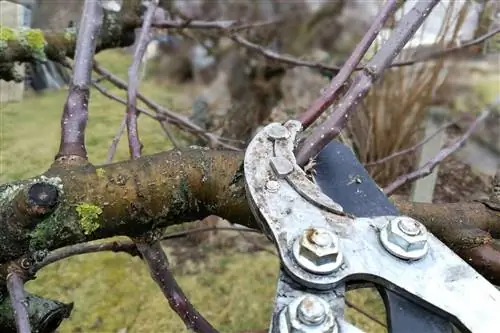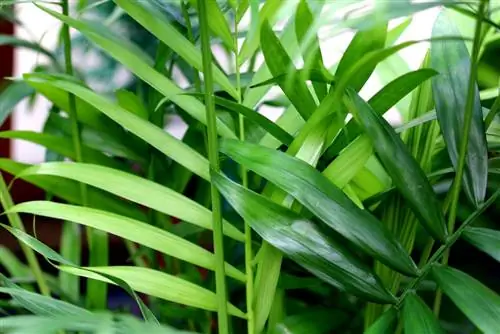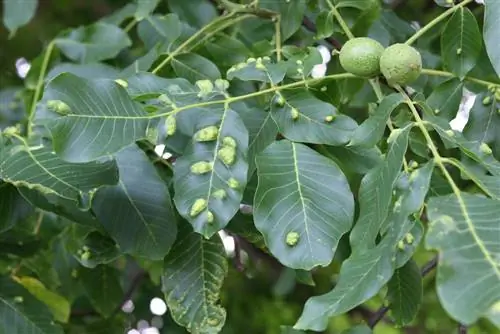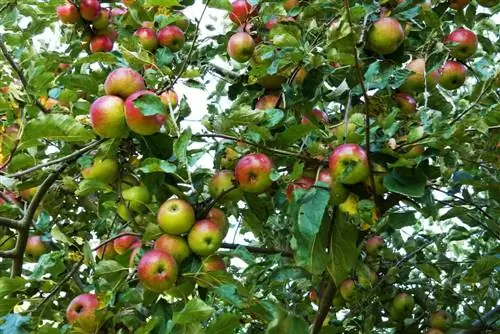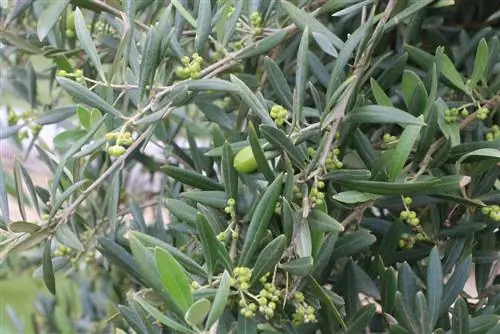- Author admin [email protected].
- Public 2023-12-17 03:39.
- Last modified 2025-06-01 06:48.
Especially in spring and autumn, many people use saws or pruning shears and use them to attack the trees. The result is far from always as desired. Sometimes the shoots are disturbed, sometimes not removed enough. Instead of achieving the desired look, the trees appear almost mutilated or grow strangely wild and chaotic. If you want to prevent this, the following tree pruning instructions are the best choice. What has to go? What can stay? When is the right time for the blend?
Periods
For almost all trees, tree trimming should be done during the resting phase, i.e. during the growing season. This begins in late autumn with the fall of the leaves and ends shortly before the next shoots in spring. Many gardeners miss the right moment and thereby damage the new shoots. Proof of this are trees that only bear a few fruits, sprout on one side or show weak growth.

If you don't have enough time in the spring, you should do the tree trimming in the fall before the first frost. Then the plants still have enough time to recover and the new growth is not disturbed. Exceptions here are trees that grow densely but have only a few fruit heads. This includes, for example, pastures. These are best advised with a thinning trimming in summer.
Step by step
No matter how many differences there are in the correct cutting of different tree species, some basics always remain the same. These are summarized in the following tree pruning instructions.
- Clean the cutting tools thoroughly and ideally disinfect them.
- Pay attention to your own safety when working.
- First remove small disruptive factors. These include so-called water shoots, which shoot up thinly and individually, as well as shoots that grow inwards.
- Depending on the type of tree, mark the lengths to be removed, for example with chalk.
- If possible, cut from top to bottom to maintain appropriate lengths.
- Remove side shoots so that the interfaces are just outside an astring. The branch ring is a bulging thickening just in front of the trunk or next thicker branch.
- For frayed cuts, rework with a knife until the wound is smooth and straight.
Common errors - checklist
Cut at sub-zero temperatures
During frost, unexpected damage can be done to the tree. The bark can crack or break, the interfaces can freeze and die. Even for plants that are best cut in winter, frost-free days should be waited for.
Leave large interfaces untreated
What is not a problem with small cuts can lead to germ and pest infestations in areas with a diameter of more than two centimeters. However, only if the cutting was not carried out correctly or there is an increased risk of infections. If the interfaces are frayed or the tree or surrounding plants are suffering from diseases, a sealant should be applied. However, only after the area in question has been disinfected. Otherwise, it is important to trust in the self-healing powers of the tree.
Use unclean work equipment
The saw or pruning shears have been in the shed all year round and are only used to trim the tree? This means that infections are almost inevitable. All cutting tools must be thoroughly disinfected before and after each use - including between different trees. In this way, germs and possible pests cannot be transferred to the interfaces. This also prevents potential infection between the trees.
Leave frayed interfaces
The bark is frayed, the last piece of the branch has broken away - if you leave it like that, you risk damaging the tree. The irregular wounds are much more difficult to close and therefore run the risk of becoming entry points for diseases and pests. It is better to create smooth areas here.
Aim for wrong form
The optimal shape is always tapering upwards. The reasons for this are very simple: On the one hand, light and air reach all branches and areas of the tree. On the other hand, the tree offers less surface area for wind and precipitation to attack. However, if the tip is too wide, snow and storms can cause branches to break off.
Tips
The most important thing when cutting trees is to take individual characteristics into account. From choosing the right time to the extent of the correction, these factors can vary significantly from tree to tree. Comprehensive research in advance is therefore crucial. In most cases, leaving straight and smooth interfaces is also crucial. If this doesn't work on the first try, you should use a knife or cutter.
Never trimmed a tree or do you always have problems with it? Looking around the area helps. Can you find a property or garden with always perfectly shaped trees? On the one hand, these can serve as an illustrative example, and on the other hand, the owners can be asked for practical tips. If that doesn't work, asking at a nursery or tree nursery will help.
Safety precautions
Shaky ladders, blunt cutting tools and slippery sprouts - you also have to pay attention to your own safety when trimming trees. Anything that cannot be reached without a ladder should, if possible, be handled with a helper. If one cannot be found, cutting tools with telescopic handles are a good alternative. In addition, the utensils should be sharp and always kept away from the body. Ladders must be stable before they are climbed on.
Frequently asked questions
Can closing a wound after pruning damage the tree?
Yes. If existing germs or pests are trapped under the sealing agent, they can multiply and spread unnoticed for a long time. Under unfavorable circumstances, closing the interfaces can even increase the risk of disease and pest infestation.
Do I have to trim every tree?
No. Many trees, especially ornamental trees, do well without cuttings. Individual research is again crucial here.
Should I rather cut too much than too little?
Most trees tolerate being pruned too radically rather than too gently. If the pruning is too severe, the trees will recover in the long term; if it is pruned too gently, they can 'overgrow'. In the long run, however, neither extreme is ideal. However, with increasing practice in tree pruning, you will usually find the feeling for the right length.
Things worth knowing about tree pruning in brief
Basic
- Tree trimming can be done at any time. However, it is usually done in the spring before budding.
- Fruit trees can and often are cut back in spring and autumn - see fruit tree pruning.
- In comparison, fruit trees are pruned more generously than other trees so that the fruit thrives better.
- The general rule is: All secondary shoots (=competing shoots) are cut off, the main shoots are shortened.
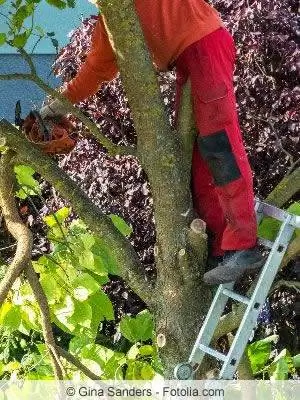
Pruning according to tree age
When pruning a tree, it also depends on how old the tree is: the flowers should be removed in the first year. This procedure has a positive effect on root formation. From the 2nd year onwards, training pruning is carried out regularly, starting with the first rule of tree pruning. The side shoots are shortened by about a quarter. Shoots that grow upwards or inwards and the second central shoot are removed. The main shoot also receives a cut and is left a hand's width longer than the side shoots. Old trees are often treated radically: they are given a rejuvenation cut, which means that up to a third of the tree crown falls victim.
Cutting and lacerations
- The correct approach to the cut must be taken into account when pruning a tree: you should always saw or cut directly behind the branch diagonally from top to bottom.
- The tree often closes smaller cuts itself if the weather is right for cutting. Sunny and frost-free days are best.
- If cuts occur that are larger than 3 cm in diameter, they are best closed with special wound closure agents - e.g. a coat of lime. These also protect against pathogens penetrating the tree.

